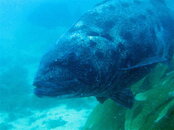HBDiveGirl
Contributor
- Messages
- 1,329
- Reaction score
- 45
- # of dives
- 1000 - 2499
Anything but! As Dr. Bill mentioned, we did see 8 GBS's on a single dive last weekend at the dive park. We saw at least one Big Fish on 10 of our 13 dives. We even saw one while free-diving with the scooters. It was insane! The place was just infested with the big darlings.Mantasscareme:The big black bass seem more aloof to me.
They are calm to the point of hypnotic... until one of the fellas decides to chase off another fella!
Four of us were hovering very near a group of three GBS... a female with her head toward the kelp, and two males with their heads Very near the female. All was calm and mellow... until the biggest male charged explosively toward the other male, nearly making contact, and the "little guy" fled. The 5-foot long "little guy."

As the Big Guy turned back toward the female, there was a startling moment when it felt like he lined up on Ken and started to charge. :scared:
But the fish slowed, continued his turn, and nuzzled back in toward the female.
We all back-kicked ever so slightly and gave Mr. Seabass a little more room.
They ignored us for many more minutes before slipping away into the kelp forest.
It was spectacular.
All the rest of the GBS's either ignored us, or came over to hover next to us, or moved away and then back to us. It seems to me they are curious about divers... especially divers who hover motionless and breath very slowly and turn sideways so as to be parallel with the fish. It seems they're trying to figure out if we're fun to hang with.
It's a great experience, and I wish all SoCal divers the joy of this experience.
Dive quietly, learn to hover motionless, and keep your eyes open.
Oh... and Dive to Stay Found!
~~~~
'Chica




